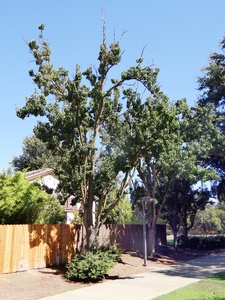Pear Trees are trees in the genus Pyrus. They are members of the Maleae (apple) tribe of the Amygdaloideae subfamily of the rose family. Other members of this tribe include apple trees, cotoneaster, hawthorn trees, photinia, and toyon.
Pear fruits are best picked slightly before they are ripe. The time period for which they are perfectly ripe lasts only a day or two and is best detected by feeling for a slight softening around the stem.
Pear Place in Woodland is named after pear trees. In addition, it's likely that Bartlett Avenue in Woodland may be named after Bartlett Pears.
 These Callery Pear (Pyrus calleryana) trees in Gary Traynham Park are invasive weeds. Photo by queerbychoice.Callery Pear (Pyrus calleryana or Pyrus kawakamii), also called Flowering Pear or (inaccurately) Evergreen Pear, is a thorny, deciduous or semi-deciduous invasive weed from Asia. It spreads via seeds and root suckers and is notorious for its unpleasant smell (which inspired the Davis LocalWiki to dub these trees Cumbleberry trees). It usually grows 15 to 25 feet tall but occasionally more than 40 feet tall. With a lifespan of only about 25 years, it is known for its propensity to develop narrow, weak branch crotches, making it highly susceptible to limb loss during storms or stress. Its fruits are less than half an inch in diameter and remain very hard until softened by frost, at which point they are commonly eaten by birds, which disperse the seeds throughout the neighborhood. Though these trees have been widely marketed as self-sterile and seedless because genetically identical clones are largely unable to pollinate one another, multiple genetically distinct cultivars are commonly sold and perfectly capable of cross-pollinating the other cultivars. Additionally, Callery Pear clones are commonly grafted onto genetically distinct Callery Pear rootstock, so if the rootstock sprouts from below the graft, the rootstock is also perfectly capable of pollinating the "sterile" cultivar that is grafted to it.
These Callery Pear (Pyrus calleryana) trees in Gary Traynham Park are invasive weeds. Photo by queerbychoice.Callery Pear (Pyrus calleryana or Pyrus kawakamii), also called Flowering Pear or (inaccurately) Evergreen Pear, is a thorny, deciduous or semi-deciduous invasive weed from Asia. It spreads via seeds and root suckers and is notorious for its unpleasant smell (which inspired the Davis LocalWiki to dub these trees Cumbleberry trees). It usually grows 15 to 25 feet tall but occasionally more than 40 feet tall. With a lifespan of only about 25 years, it is known for its propensity to develop narrow, weak branch crotches, making it highly susceptible to limb loss during storms or stress. Its fruits are less than half an inch in diameter and remain very hard until softened by frost, at which point they are commonly eaten by birds, which disperse the seeds throughout the neighborhood. Though these trees have been widely marketed as self-sterile and seedless because genetically identical clones are largely unable to pollinate one another, multiple genetically distinct cultivars are commonly sold and perfectly capable of cross-pollinating the other cultivars. Additionally, Callery Pear clones are commonly grafted onto genetically distinct Callery Pear rootstock, so if the rootstock sprouts from below the graft, the rootstock is also perfectly capable of pollinating the "sterile" cultivar that is grafted to it.
Callery Pear is planted at Campbell Park, Christiansen Park, Everman Park, Gary Traynham Park, John Ferns Park, Joseph Schneider Park, Pioneer Park, Ralph Harris Park, William Crawford, Sr., Park, Woodland Opera House, Woodland Public Library, Woodland Sports Park, Woodside Park, It is also planted as a street tree on 1st Street, 2nd Street, 3rd Street, 4th Street, 5th Street, Alice Street, Bartlett Avenue, Beamer Street, Bliss Avenue, Clover Street, College Street, County Road 98, County Road 102, Court Street, Cross Street, Dead Cat Alley, Depot Street, Dog Gone Alley, Elm Street, Grand Avenue, Highway 16, East Gibson Road, Johnston Street, Matmor Road, North College Street, North Street, Pendegast Street, Pershing Avenue, Pioneer Avenue, Walnut Street, West Gibson Road, West Keystone Avenue, and Woodland Avenue. In fact, the Urban Forest Resource Analysis published by the City of Woodland in 2018 indicated that the city was knowingly and intentionally maintaining 729 of these invasive weeds in Woodland.
Edible Pear (Pyrus communis) is a deciduous fruit tree from Europe and Asia that produces the classically "pear-shaped" fruits. There are many cultivars with different characteristics, but the wild form usually grows 40 to 50 feet tall and 25 to 35 feet wide. It prefers full sun and good drainage. Bartlett Pears, which Bartlett Avenue in Woodland may be named after, are cultivars of Edible Pear. Edible Pear trees are either male or female, so they do not produce seedlings unless there are both male and female trees in the area. Only the male trees produce pollen, and the male trees are ranked 3 out of 10 on the Ogren Plant Allergy Scale, indicating that they are fairly unlikely to cause hay fever. Edible Pear is planted at Campbell Park and Woodland Sports Park. It is also planted as a street tree on Marshall Avenue.
Links
California Invasive Plant Council: Pyrus calleryana


